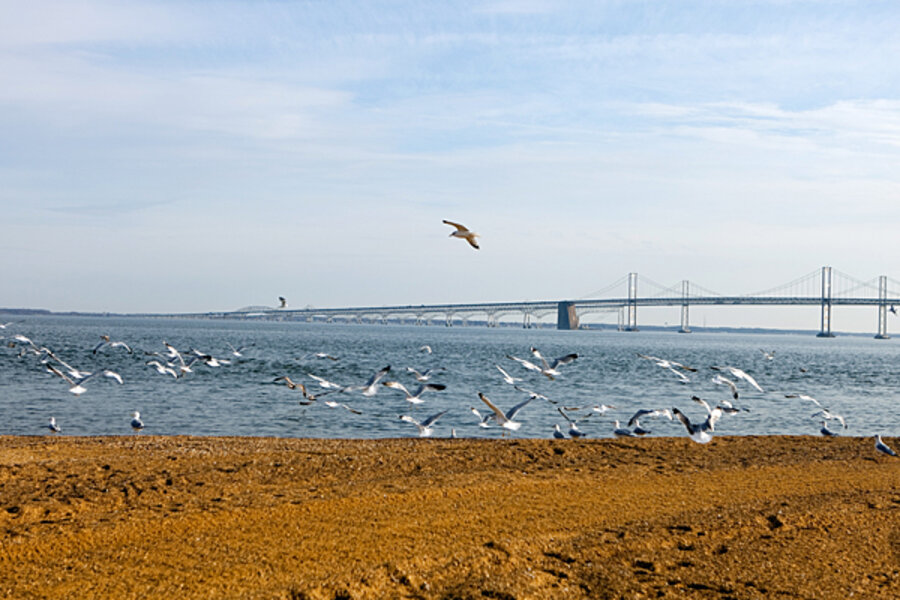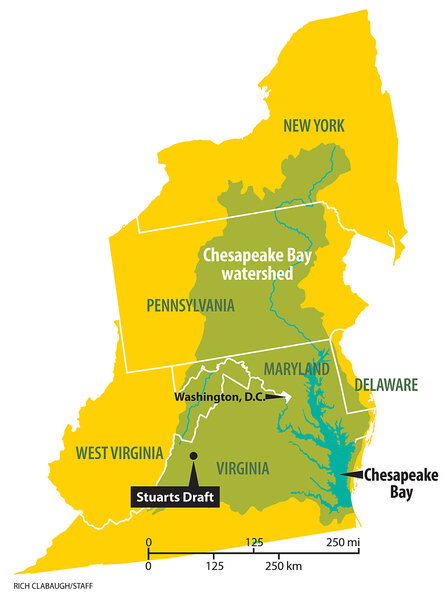Farmers, EPA clash over Chesapeake Bay regulations
Loading...
| Stuarts Draft, Va.
Lloyd McPherson bought his farm in the Shenandoah Valley, along the headwaters of the Chesapeake Bay, more than 20 years ago. Back then, the Chesapeake was far from sight and mind. But now, as the Environmental Protection Agency (EPA) launches a new effort to clean up the bay, Mr. McPherson and his farming neighbors find themselves swept up in the largest and most ambitious water-restoration project ever attempted in the United States.
"It's very, very complex," says McPherson, casting an anxious glance at his pasture on a snow-covered hillside above Christians Creek. "Nobody knows what they're going to demand."
In late December, the EPA set limits for nitrogen, phosphorous, and sediment pollution in each of the bay's major tributary rivers. These limits are part of a TMDL, or total maximum daily load – a regulatory mechanism created by the Clean Water Act.
While thousands of TMDLs have been created over the past several decades, none has been attempted on such an enormous scale. The bay's 64,000-square-mile watershed stretches across parts of New York, Pennsylvania, Maryland, Delaware, Virginia, and West Virginia, plus Washington, D.C. It is home to almost 17 million people, as well as nearly 500 large public and industrial waste-water treatment plants.
"This isn't your mother's TMDL," says Roy Hoagland, the Chesapeake Bay Foundation's vice president for environmental protection and restoration. "This is something significantly different in the arena of restoration of waters in this nation."
But for many farmers, the TMDL is hardly the best thing since the combine. The EPA has identified the watershed's nearly 88,000 farms as the largest source of nutrient and sediment pollution entering the bay. Many in the agricultural industry fear that the cost of increased pollution controls will place onerous financial burdens on them.
So on Jan. 10, the American Farm Bureau Federation (AFBF) and the Pennsylvania Farm Bureau filed suit in federal court to block the TMDL.
"We're very concerned that ... [the TMDL is] going to push agriculture out of the watershed," says Don Parrish, AFBF senior director of regulatory relations.
This isn't the first time that people have tried to decontaminate the Chesapeake. It's been the subject of cleanup efforts since the 1980s, when nutrient and sediment pollution reduced its famous oyster populations to an estimated 1 percent of historic levels and oxygen-depleted "dead zones" began covering up to 20 percent of the bay each summer.
While some progress has been made, such as the blue crab population's recent rebound, the overall situation remains little improved. In its 2010 "State of the Bay" report, the Chesapeake Bay Foundation declared the bay ecosystem "dangerously out of balance."
Hence the EPA's unprecedented cleanup effort, which may get less federal funding as congressional Republicans push for budget cuts. An amendment to the recently passed House budget bill, added by Rep. Robert Goodlatte (R) of Virginia, would eliminate all EPA funding to develop and implement the TMDL. Though it is unclear if it will prevail in final negotiations.
A key aspect of the cleanup plan is that each state within the watershed will decide how to meet the EPA's targets, says Jon Capacasa, director of the water-protection division for the EPA's mid-Atlantic region.
In other words, states will choose their strategies – whether increased control of runoff from farms, stricter regulation of industrial effluent, restriction of fertilizer use on residential lawns and golf courses, or some combination of these options.
Right now, states are drawing up detailed plans for pollution reductions on a stream-by-stream scale throughout the watershed. The due date for these plans will be determined soon.
At stake: federal grant money
The TMDL, which sets a completion date of 2025, also outlines consequences that the EPA will impose on states that fail to make sufficient headway. Among these are the withholding of EPA grant money and stricter requirements for federally regulated pollution sources such as factories and waste-water treatment plants.
"This plan gives me the greatest optimism I've ever had," says Mr. Hoagland, who has worked on bay issues for nearly 25 years.
Agricultural groups beg to differ. After the lawsuit was filed, Virginia Farm Bureau president Wayne Pryor issued a statement supporting bay restoration in principle, but warning that the TMDL puts "the entire economy ... at stake."
The lawsuit raises several objections to the cleanup plan. First, as the TMDL neared completion, groups like the AFBF increasingly criticized data used in its development. One complaint focused on the EPA's exclusion of data on existing, "voluntary" conservation measures – ones that farmers have undertaken outside public-subsidy programs and that therefore are mostly unrecorded.
Although the EPA has acknowledged this shortcoming and is working on an accounting system for voluntary practices, farmers worry that credit will not be issued quickly for existing conservation efforts and that the agriculture sector will thus be asked to make more than its fair share of pollution reductions.
Another criticism centers on inconsistencies between EPA data used to develop the TMDL and data collected by the US Department of Agriculture for a report on farm pollution controls in the watershed. These discrepancies were identified last fall in a study commissioned by several agriculture groups.
The EPA has defended its data. According to Mr. Capacasa, the expansive set of bay water-quality data gathered during previous restoration efforts has allowed the agency to write the most scientifically rigorous TMDL ever. That claim has the support of several prominent university scientists in the bay region, who signed a letter last fall declaring the scientific community's consensus that the TMDL data and models are "both useful and adequate."
EPA has 'overreached,' critics say
The lawsuit, Mr. Parrish says, also claims that the EPA overstepped its authority granted under the Clean Water Act, because it has set individual pollution limits for each state in the watershed and for the bay's tributary rivers.
"The ends in this case do not justify the means.... We believe the EPA overreached," Parrish says.
Capacasa responds that the EPA believes it has a "very defensible TMDL that meets the requirements of the Clean Water Act."
The EPA, which has until March 14 to respond to the lawsuit, is now reviewing the case, Capacasa says.
While the American and Pennsylvania farm bureaus are the only groups so far to challenge the TMDL in court, municipal storm-water associations in Virginia and Maryland have also expressed concern about the TMDL's economic impact. Both groups cite a study that estimated a cost of at least $700 per household per year to retrofit urban storm-water controls to satisfy the pollution allocations included in a draft version of the TMDL.
Back at his farm just outside Stuarts Draft, Va., McPherson lists the actions he's already taken over the years to protect Christians Creek and, ultimately, the bay: adopting no-till practices instead of repeatedly plowing his fields, fencing his cattle from long sections of the creek, and fertilizing his crops with far more precision and restraint than the "happy homeowners" whose emerald lawns also drain into the bay.
"There's so much that we've changed," he says, the sunset casting a glow across the barnyard. "[But] we're [still] getting singled out because we're the ones who can be controlled the easiest."



